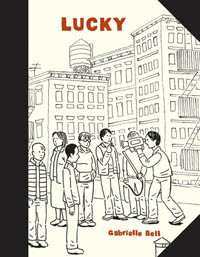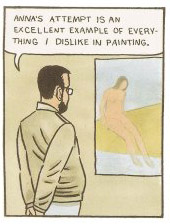 Home > CR Interviews
Home > CR Interviews A Short Interview With Gabrielle Bell
posted November 5, 2006
A Short Interview With Gabrielle Bell
posted November 5, 2006

You know as a critic you're dealing with a promising cartoonist when you're putting together an interview about their latest book and you find yourself hoarding questions because you want to ask it in a later piece with a broader mandate, even if it's years and years from now. That's where the cartoonist
Gabrielle Bell is right now, at least in my mind. Her comics work in a variety of sources is just beginning to come into that super-tight focus that will ignite a group of new and devoted readers that will send the next six months tracking down everything Bell has done in her entire career.

Gabrielle Bell's new book is
Lucky, from
Drawn and Quarterly, a collection of previously serialized slice of life comics that at first glance are the exact type that sends your average doltish champion of punchy-kicky books into anti-elitist apoplexy. The drawing style is sedate, the focus is on real-world experiences, incidental details sometimes overwhelm the main "narrative," and very little of consequence is resolved from strip to strip. The irony of the anti-autobio criticism of art comics is that it's hopelessly outdated. Following a generation of cartoonists that was temporarily enamored of the possibilities presented by Harvey Pekar, almost no one works in the first-person, memoir-style, approach-driven reportage anymore. And even if every second person did, there would still be a place for someone as skillful at staging and pacing as Bell. Like the absolute best autobiographically-based comics, the better strips from Bell are totally immersive but also feel like a snapshot of a tiny part of the human existence. I could read a similar book three times as long.
But it's misguided to think of Bell strictly as an diarist; a lot of her work can be fanciful, and she's talented at what we might call straight fiction as well. I think Bell's comics are tremendously and frequently funny in a way that most other cartoonists barely manage, a humor that comes out of deadpan depictions of people behaving just a tiny bit like buffoons, and a sensitivity towards how a lot of people can careen back and forth between avoidance and confrontation. Without those qualities, her feature about an artist and teacher in the fourth volume of
Drawn and Quarterly Showcase might have been intolerably dull and depressing, but the light touch allows the reader to focus in on the observant particulars of the relationship between Bell's adult protagonist and a 12-year-old with fascination rather than feeling like one is having their faced rubbed in something indiscreet, and pick up on the shadings in the intellectual and artistic issues that make an appearance. Bell may be the best argument going for improvement through working, the thousand of tweaks and takes and experiments that drive a fruitful comics career.
*****
TOM SPURGEON: Gabrielle, I kind of lost track of you between the time Jeff Mason came out with When I'm Old and Drawn and Quarterly's Lucky
. Can you fill me in on what you've been doing, who you've been doing it for, and how the D&Q book came about?
GABRIELLE BELL: I did a lot of anthologies:
Kramers Ergot,
Sheherezade,
The Comics Journal Winter Special, then
Mome and the
Drawn & Quarterly Showcase.
Lucky was a journal/autobiographical minicomics series that I mostly just sold at shows and ran on www.serializer.net.
SPURGEON: My memory of your earlier work is that you worked with outsized, slightly fantastic elements frequently, and other than the Sadie story that appears in this volume, I don't see that anymore. Am I right in that your work is focused a bit differently now than when we first started seeing your comics? How would you describe your current interests in what you want to do with your comics?
BELL: I am still doing fantastical work. There's also
The Hole, and my
Kramer's Ergot comic, and my latest mini-comic,
My Affliction, is very much that. There are several things I want to do with comics and that is one of them. But also I want to do real stories that could actually happen. And I want to do stories that actually DID happen, more or less.
SPURGEON: Can you talk about the section of the book where you work in four panels and with a lot of heavier blacks? They're very striking. What prompted you to use those two visual parameters?
BELL: The first chapter of
Lucky was purely diary strips. The second I began extending the stories and making them into something more considered, less immediate. In doing that, the visual format changed too. When I take the storytelling more seriously, I take the art more seriously with it.
 SPURGEON: A lot of your comics deal with uncomfortable moments, and, when applicable, what you've done to negotiate those moments. Is that something you find particularly interesting, the way life puts people into such moments and the abilities we bring to bear in order to get through them?
SPURGEON: A lot of your comics deal with uncomfortable moments, and, when applicable, what you've done to negotiate those moments. Is that something you find particularly interesting, the way life puts people into such moments and the abilities we bring to bear in order to get through them?
BELL: Yes. What interests me is stories about human relationships on all levels, but I am paradoxically afflicted with a terrible shyness and also maybe a sort of disdain for most people. It is an inspiring thing for me when I am forced by the circumstances of life to deal with the world around me. I generally don't draw comics that don't have some sort of human interaction. It's a sort of compelling struggle for me. So the uncomfortable moments in my comics are my awkward and fumbling attempts at understanding and communication with other people, which is the best I can do for now.
SPURGEON: One thing I like about your comics is how gracefully you switch perspectives. How do you block out your comics in terms of what you'll show and from what angle? Is it just a matter of keeping things visually interesting, or in something like the strip about your mother reading, does the perspective you choose to show part of the mood or the feeling you're trying to get across to the reader?
 BELL:
BELL: I don't really think about perspective that much. The thing I think about a lot nowadays is whether a thing in a comic is necessary to the story. I want the story to be clear, and I don't want my audience to have to read it again and again to figure out what's going on, but in the past year or two I've been constantly asking myself about each element of my story "Is this necessary?" I
think (I can't say for sure) that the trick to effective changes in perspective is to not have any extraneous panels to clutter it up and call attention to itself. Nowadays I find that if I find the panel tiresome or boring to do, it often means it's extraneous.
SPURGEON: What cartoonists do you
find funny and why?
BELL: I think
Karen Sneider is very funny. She is a highly developed comedienne but also knows how to draw and tell a story. Also I just got a comic called
Fart Party by Julia Wertz. It's hard to explain why something is funny! She talks about a diarrhea mask at Christmas dinner with her new step-family. I can't really analyze the mechanics of the humor at work there!
*****
Lucky, Gabrielle Bell, Drawn & Quarterly, Softcover, 112 pages, November 2006, 189729901X (ISBN), $19.95
Drawn & Quarterly Showcase Book Four, Gabrielle Bell/Martin Cendreda/Dan Zettwoch, Drawn & Quarterly, Softcover, 102 pages, November 2006, 189659798X (ISBN), $14.95.


